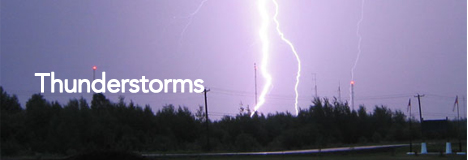
Thunderstorms are common on the prairies. They are often accompanied by hail, lightning, high winds, heavy rain and, occasionally, tornadoes.
- Lighting – Lightning is a killer. No other aspect of severe summer weather presents more of a danger than lightning. Bolts of lightning hit the ground at about 40,000 kilometers a second and can carry an electrical charge of as much as 1 million volts.
The 30-30 rule – To estimate how far away lightning is, count the seconds between the flash of lightning and the thunderclap. Each second is about 300 metres. If you count fewer than 30 seconds, look around for shelter. If you count fewer than five seconds, take shelter urgently - this means lightning is near and you do not want to be the tallest object in the area. It is recommended to wait 30 minutes after the last lightning strike in a severe storm before venturing outside again.
Taking shelter from lightning – If you’re indoors, stay away from windows, doors, fireplaces, radiators, stoves, sinks, bathtubs, appliances, metal pipes, telephones, and other materials that conduct electricity. Unplug your radios and TVs.
If you are outdoors, take shelter in a depressed area such as a ditch or culvert, but never under a tree. Do not ride bicycles, motorcycles or golf carts or use metal shovels or golf clubs. If you are swimming, return to land immediately. If you are caught in the open, do not lie flat. Crouch in the leapfrog position and cover your head. If you are in a car, stay there but move your car away from any trees.
- Heavy Rain – A heavy rainfall can cause flooding. This is particularly true when the ground is already saturated from previous storms. If you know there is flooding or the possibility of flooding in your area, keep your radio on to find out what areas are flooded, what areas are likely to be flooded, as well as what roads are safe, where to go and what to do if the local emergency team asks you to leave your home. Generally speaking, it is a good idea to avoid driving through flooded roads and underpasses. The water may be a great deal deeper than it looks and you could put yourself in danger.
- Hail – Take cover when hail begins to fall. Do not go out to cover plants, cars or garden furniture or to rescue animals. Hail comes down at great speed, especially when accompanied by high winds. Although no one in Canada has been killed by hail, people have been seriously injured by it.

